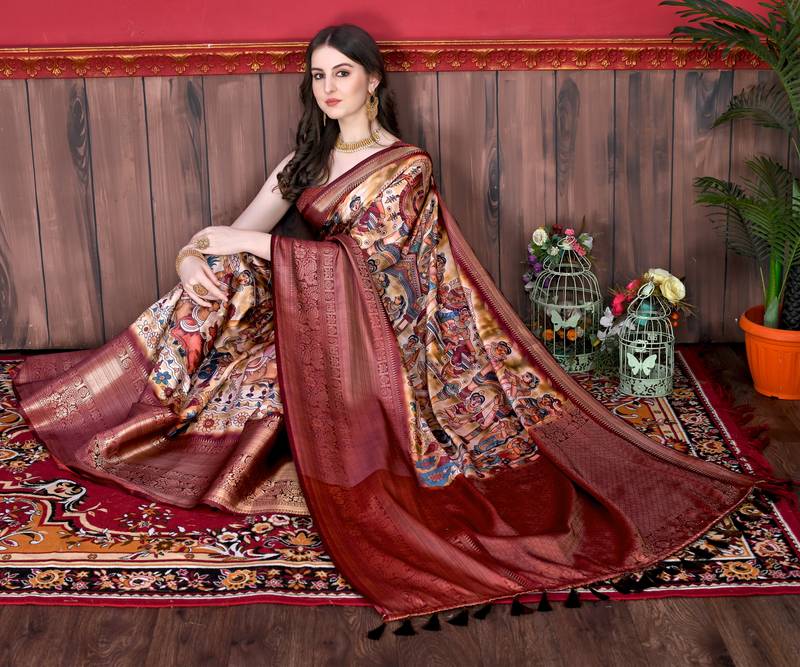Traditional Sarees With A Touch Of Tech

Strong 8k brings an ultra-HD IPTV experience to your living room and your pocket.
For a long time, sarees have been the epitome of grace. A well-known attire that represents the richness of Indian clothing, sarees come in a wide range of colors, fabrics, and patterns. As the trends for sarees have changed with the new generation of fashionistas, so the ways to make and sell them have also changed. Particularly in recent years, technology has played a crucial role in reshaping the saree industry. From digital design tools to e-commerce platforms, technology is revolutionizing every aspect of the saree business. In this blog, we will see how the wave of technology has changed the saree industry, which has ultimately benefited customers all over the world. So here let us get to know how this benefits you to get the best sarees for your wardrobe.
1. Digital Printing and Design Innovations
New digital tools have made saree designs more creative and efficient. With the technology of digital printing, customers not only get to choose colors but also patterns, motifs, and even print personal photos. For example, brides can have wedding sarees with intricate, one-of-a-kind patterns. Earlier, weaving detailed designs like Banarasi or Kanjeevaram sarees took months. Now, digital weaving machines can replicate these designs quickly without losing quality.
2. E-Commerce and Virtual Shopping Experiences
Online shopping has made it easier for people to buy sarees without visiting physical stores. Instead of traveling to different stores, buyers can browse thousands of sarees, compare prices, and order from home with just a few clicks. For example, a weaver in Varanasi can now sell a saree to a customer in any part of the world. With virtual try-on, some online stores let customers see how a saree would look on them. This helps them in buying high-quality sarees while doing online saree shopping.
3. Sustainable Manufacturing Practices
Technology is helping saree manufacturers create eco-friendly products and reduce waste. Nowadays, smart cutting machines ensure that saree fabrics are used efficiently, minimizing leftover material. Some saree brands are using natural dyes made from plants and minerals instead of harmful chemical ones. To ensure the artisans get fair wages and the production process remains ethical, blockchain technology is used. It helps track a saree’s journey from raw materials to finished product.
4. Social Media and Influencer Marketing
In today’s time, social media is playing a huge role in how sarees are marketed and sold. This tool makes it easier for brands to reach various demographics, as well as global buyers. There are various tactics to ensure the brands do it right.
Fashion influencers on Instagram, YouTube, and TikTok showcase different saree styles and review them, talking about their advantages and disadvantages. This inspires audiences to make informed decisions while purchasing sarees. Many saree brands now host live sessions on Facebook, Instagram, and YouTube or their brand application, where customers can ask questions and see sarees in real time before online shopping.
As reels and other forms of short content are quite trending, the brands curate short videos showcasing saree styling tips, fabric details, and celebrity saree looks. These videos are informative, highly engaging and help brands gain viral reach. Many saree brands use hashtags like #SareeLove and #SixYardsOfGrace or even make their own to encourage customers to share their saree looks, creating a strong online community.
5. AI-Powered Trend Forecasting
Amongst many other ways Artificial Intelligence (AI) changed the world, one aspect it touched was also the way customers buy sarees online. Traditional saree businesses used to rely on experience and manual market research to anticipate what customers wanted. Now AI is being used by the saree industry to predict fashion trends and customer preferences to make this process faster and more accurate.
AI takes and analyzes data from e-commerce platforms, social media, and past sales records to determine which saree colors, patterns, or fabrics are trending. This helps designers and manufacturers create sarees that are more likely to sell. For example, an online saree store notices that pastel shades and floral prints are trending due to Bollywood celebrities wearing them. So these kinds of sarees would be produced and kept in the inventory to meet customer demand.
Like any other industry, both overstocking and understocking are major problems in the saree industry. Since AI helps brands forecast demand more accurately, preventing excess production or shortages. Some AI systems recommend sarees based on a customer’s browsing history, making online shopping more personalized.
So, as you can understand, technology has changed the online shopping experience for good. With these innovations, you can buy sarees anytime in a hassle-free way.
Note: IndiBlogHub features both user-submitted and editorial content. We do not verify third-party contributions. Read our Disclaimer and Privacy Policyfor details.



